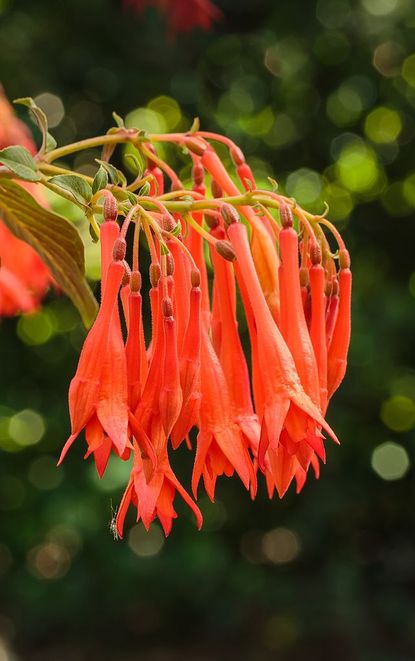Fuchsia Gartenmeister Information – What Is Gartenmeister Fuchsia Plant


“Across the downs a hummingbird came, dipping through the bowers, he pivoted on emptiness, to scrutinize the flowers,” said Nathalia Crane. If you are looking for a reliable bloomer to attract hummingbirds, butterflies, and bees to your garden, try a Gartenmeister fuchsia. What is Gartenmeister fuchsia? Continue reading to learn about growing Gartenmeister fuchsias.
Fuchsia Gartenmeister Information
What is Gartenmeister fuchsia plant? Native to the West Indies, Gartenmeister fuchsia (Fuchsia triphylla 'Gartenmeister Bonstedt') is a continual blooming, shrubby evergreen in zones 9 to 11. Grown as an annual in cooler climates, Gartenmeister fuchsia is more heat tolerant than other fuchsias. It is sometimes called honeysuckle fuchsia because its long, tubular, orange-red flowers resemble honeysuckle flowers. Growing 1 to 3 feet (31-91 cm.) tall and wide, Gartenmeister fuchsia grows upright when young but becomes more pendulous with age. It also displays attractive green-bronze foliage with purple-red undersides on red stems. Gartenmeister fuchsia is a sterile hybrid of Fuchsia triphylla, meaning it rarely produces seeds and, when it does, the seed will not produce an identical offspring to the parent plant. Gartenmeister fuchsias can be successfully propagated by cuttings or divisions though.
Gartenmeister Fuchsia Care
Like all fuchsia plants, they are heavy feeders and will need regular fertilizing with an all-purpose, general fertilizer once a month through the blooming period. Flowering on new wood, Gartenmeister fuchsias bloom from spring to frost in cooler climates and year-round in tropical climates. It can be deadheaded as needed anytime throughout its blooming period. Gartenmeister fuchsia can be grown directly in the garden or in containers. It prefers moist, well-draining, slightly acidic soil in part shade. It may be necessary to mist this fuchsia daily in hot, dry periods. Adding extra mulch around the plant can help keep the soil cool and moist. In cooler climates, it can be cut back and overwintered indoors. Whenever taking plants indoors for the winter, be sure to treat them for pests first. Gartenmeister fuchsia can be prone to whiteflies, aphids, spider mites, and scale.
Gardening tips, videos, info and more delivered right to your inbox!
Sign up for the Gardening Know How newsletter today and receive a free download of our most popular eBook "How to Grow Delicious Tomatoes."
-
 Want a Backyard Mini Orchard? Create Your Own Container Orchard
Want a Backyard Mini Orchard? Create Your Own Container OrchardEasier to care for in small spaces, a backyard mini-orchard makes sense for busy gardeners and juicy fruit is the reward.
By Teo Spengler
-
 Urban Beekeeping Guide: Top Tips For Raising Bees In The City
Urban Beekeeping Guide: Top Tips For Raising Bees In The CityUrban beekeeping can be a rewarding and appreciated pastime, but first be sure it’s legal in your city and learn the ropes of beekeeping.
By Mary Ellen Ellis